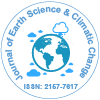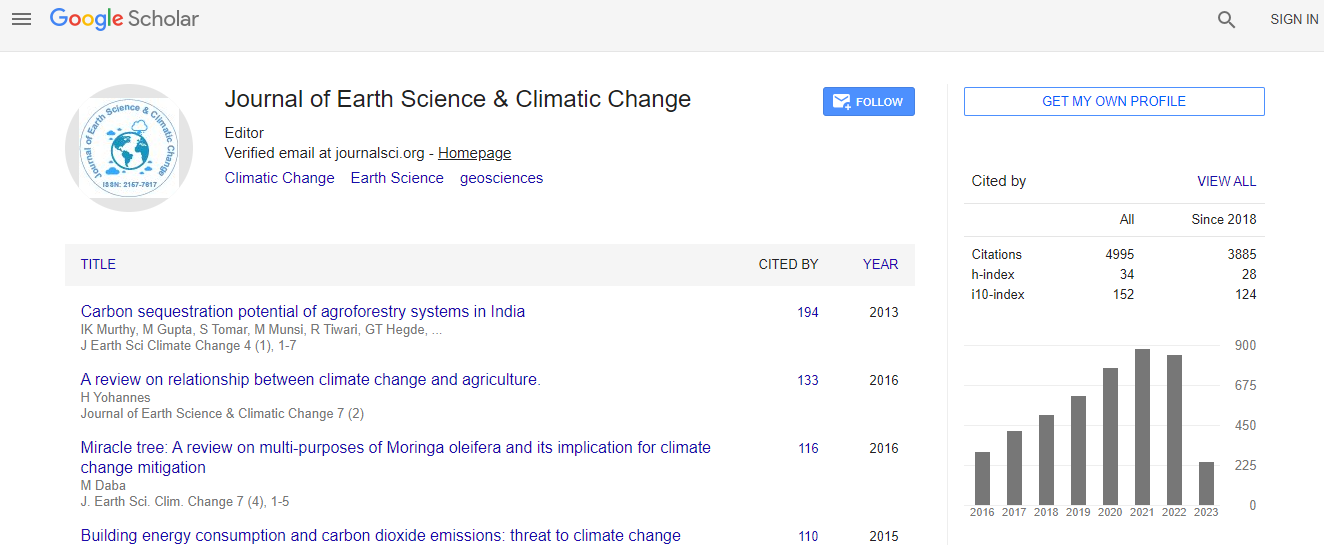Our Group organises 3000+ Global Conferenceseries Events every year across USA, Europe & Asia with support from 1000 more scientific Societies and Publishes 700+ Open Access Journals which contains over 50000 eminent personalities, reputed scientists as editorial board members.
Open Access Journals gaining more Readers and Citations
700 Journals and 15,000,000 Readers Each Journal is getting 25,000+ Readers
Google Scholar citation report
Citations : 5125
Journal of Earth Science & Climatic Change received 5125 citations as per Google Scholar report
Journal of Earth Science & Climatic Change peer review process verified at publons
Indexed In
- CAS Source Index (CASSI)
- Index Copernicus
- Google Scholar
- Sherpa Romeo
- Online Access to Research in the Environment (OARE)
- Open J Gate
- Genamics JournalSeek
- JournalTOCs
- Ulrich's Periodicals Directory
- Access to Global Online Research in Agriculture (AGORA)
- Centre for Agriculture and Biosciences International (CABI)
- RefSeek
- Hamdard University
- EBSCO A-Z
- OCLC- WorldCat
- Proquest Summons
- SWB online catalog
- Publons
- Euro Pub
- ICMJE
Useful Links
Recommended Journals
Related Subjects
Share This Page
In Association with

Characterization of surface and trapped dust samples collected from human settlements that are in the vicinity of abandoned and ownerless mine tailings in Mpumalanga province, South Africa
5th International Conference on Earth Science & Climate Change
Shadung J Moja and Maphuti Kwata
Council for Geoscience, South Africa
ScientificTracks Abstracts: J Earth Sci Clim Change
Abstract
Asbestos mining was banned in South Africa because of the health effects that are linked to the inhalation of asbestos dust / fibres. Most of asbestos mine tailings in Mpumalanga Province are not rehabilitated and dust / fibres could easily be lifted and transported by wind, and then settle in sensitive areas like human settlements. Surface and trapped dust samples were collected around human settlements that are in the vicinity of five abandoned and ownerless asbestos mine tailings in October 2015. After collection, surface dust samples were sieved with a 100 �¼m pore size stainless steel sieve to remove large dust particles. Trapped dust material was collected around the window panes in houses, surfaces of furniture and on windscreens of old cars. Surface and trapped dust samples were treated in the laboratory in preparation of Scanning Electron Microscope â�� Energy Dispersive X- ray (SEM â�� EDX), X-Ray Diffraction (XRD) and X-Ray Fluorescence (XRF) analyses. Both, the amphibole and serpentine asbestos mineral groups were detected in most indoor and outdoor dust samples. Other dominant minerals detected include the quartz, chlorites, plagioclase, calcite, talc, pyroxene, dolomite, mica, feldspar, clay and iron oxide. Industrial and biological materials that include fly ash particles, organic fibre and fibre glass were detected. The morphological and elemental composition results will also be covered in the paper. But, the continued presence of the dangerous asbestos minerals where humans live is of concern.Biography
Shadung J Moja is currently serving as a chief scientist in air quality within the Sustainable Resources and Environment Competency at the Council for Geoscience in South Africa. His Master’s and Doctoral degrees are in Analytical Chemistry and Environmental Management respectively. He has served the academia for more than 16 years. He also has 4 years of industrial chemistry experience and more than 3 years of consulting in air quality. He has published more than 15 peer reviewed articles.
Email: sjmoja@geoscience.org.za

 Spanish
Spanish  Chinese
Chinese  Russian
Russian  German
German  French
French  Japanese
Japanese  Portuguese
Portuguese  Hindi
Hindi 
